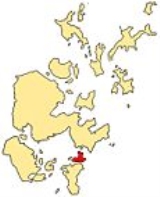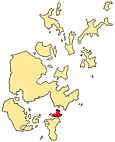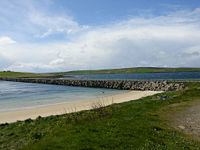
Burray
Encyclopedia
Burray is one of the Orkney Islands
in Scotland
. It lies to the east of Scapa Flow
and is one of a chain of islands linked by the Churchill Barriers
.

Burray lies between Mainland, Orkney and South Ronaldsay
, and is linked to both by the Churchill Barriers
. Barriers 1, 2, and 3 connect Burray with Mainland, Orkney via the islets of Glimps Holm and Lamb Holm
in Holm Sound to the north east. Barrier 4 links to South Ronaldsay
, across Water Sound. To the west is the tidal island
of Hunda
, also joined by a causeway. Further west, across Scapa Flow
, are the islands of Flotta
and Calf of Flotta
, approximately 6 kilometres (3.7 mi) away.
In 2001, the population of Burray was 357. The main settlement, Burray Village, is a former fishing port on the south west coast. There are also settlements of Northtown, Southtown and Hillside on the island.
Burray is made up of old red sandstone
of the Devonian
period. The island is indented in the north west by Echnaloch Bay, which takes its name from Echna Loch
. Burray Ness and Burray Haas are two headlands in the east.
and Heritage Centre at Viewforth.
The island has a reasonable amount of birdlife, with not just gulls (herring and lesser backed) breeding here, but curlew
.
of Burray was one Sir James Stewart. Stewart is said to have been involved with a murder in Kirkwall
in 1725, and went on the run for twenty years. A Jacobite
sympathiser, he ended up fighting in the Battle of Culloden
in 1746, and was one of the few survivors. However, when he returned to Burray after the battle, he happened to chance upon the son of the murder victim, who reported him to the authorities. Stewart was arrested, and ended up dying in a prison cell in London
.
The novelist Mary Brunton
was born Mary Balfour on Burray on 1 November 1778.

On 14 October 1939, the Royal Navy battleship HMS Royal Oak was sunk at her moorings within the natural harbour of Scapa Flow
, by the German U-boat
U-47 under the command of Günther Prien
. U-47 had entered Scapa Flow through Holm Sound, just to the north of Burray, one of several eastern entrances to Scapa Flow. The eastern passages were protected by measures including sunken block ships, booms and anti-submarine nets, but U-47 entered at night at high tide by navigating between the block ships.
To prevent further attacks, the First Lord of the Admiralty, Winston Churchill
ordered the construction of permanent barriers. Work began in May 1940 and the barriers were completed in September 1944, but were not officially opened until 12 May 1945, four days after the end of World War II
.
The Churchill Barriers project required a substantial labour force, which peaked in 1943 at over two thousand. Much of the labour was provided by over 1300 Italian prisoners of war, who had been captured in the desert war
in North Africa, who were transported to Orkney from early 1942 onwards. As the use of POW labour for War Effort works is prohibited under the Geneva Conventions
, the works were justified as 'improvements to communications' to the southern Orkney Islands.
The prisoners were accommodated in three camps, 200 at Camp 60 on Lamb Holm
and the remaining 700 at two camps on Burray itself.
Orkney Islands
Orkney also known as the Orkney Islands , is an archipelago in northern Scotland, situated north of the coast of Caithness...
in Scotland
Scotland
Scotland is a country that is part of the United Kingdom. Occupying the northern third of the island of Great Britain, it shares a border with England to the south and is bounded by the North Sea to the east, the Atlantic Ocean to the north and west, and the North Channel and Irish Sea to the...
. It lies to the east of Scapa Flow
Scapa Flow
right|thumb|Scapa Flow viewed from its eastern endScapa Flow is a body of water in the Orkney Islands, Scotland, United Kingdom, sheltered by the islands of Mainland, Graemsay, Burray, South Ronaldsay and Hoy. It is about...
and is one of a chain of islands linked by the Churchill Barriers
Churchill Barriers
The Churchill Barriers are a series of four causeways in the Orkney Islands, Scotland, with a total length of 1.5 miles . They link the Orkney Mainland in the north to the island of South Ronaldsay via Burray and the two smaller islands of Lamb Holm and Glimps Holm.The barriers were built in the...
.
Geography and geology

Burray lies between Mainland, Orkney and South Ronaldsay
South Ronaldsay
South Ronaldsay is one of the Orkney Islands off the north coast of Scotland. It is linked to the Orkney Mainland by the Churchill Barriers, running via Burray, Glimps Holm and Lamb Holm.-Geography and geology:...
, and is linked to both by the Churchill Barriers
Churchill Barriers
The Churchill Barriers are a series of four causeways in the Orkney Islands, Scotland, with a total length of 1.5 miles . They link the Orkney Mainland in the north to the island of South Ronaldsay via Burray and the two smaller islands of Lamb Holm and Glimps Holm.The barriers were built in the...
. Barriers 1, 2, and 3 connect Burray with Mainland, Orkney via the islets of Glimps Holm and Lamb Holm
Lamb Holm
Lamb Holm is a small uninhabited island in Orkney, Scotland. The remarkable Italian Chapel, constructed during the Second World War, is the island's main attraction.-Geography:...
in Holm Sound to the north east. Barrier 4 links to South Ronaldsay
South Ronaldsay
South Ronaldsay is one of the Orkney Islands off the north coast of Scotland. It is linked to the Orkney Mainland by the Churchill Barriers, running via Burray, Glimps Holm and Lamb Holm.-Geography and geology:...
, across Water Sound. To the west is the tidal island
Tidal island
A tidal island is a piece of land that is connected to the mainland by a natural or man-made causeway that is exposed at low tide and submerged at high tide. Because of the mystique surrounding tidal islands many of them have been sites of religious worship, such as Mont Saint Michel with its...
of Hunda
Hunda
Hunda is an uninhabited island in the Orkney archipelago in Scotland. It is in extent and rises to above sea level. It is situated in the Scapa Flow and connected to the nearby island of Burray by a causeway built in 1941 to stop passage of small surface craft as part of the boom defences, and...
, also joined by a causeway. Further west, across Scapa Flow
Scapa Flow
right|thumb|Scapa Flow viewed from its eastern endScapa Flow is a body of water in the Orkney Islands, Scotland, United Kingdom, sheltered by the islands of Mainland, Graemsay, Burray, South Ronaldsay and Hoy. It is about...
, are the islands of Flotta
Flotta
Flotta is a small island in Orkney, Scotland, lying in Scapa Flow. The island is known for its large oil terminal and is linked by Orkney Ferries to Houton on the Orkney Mainland and Lyness and Longhope on Hoy....
and Calf of Flotta
Calf of Flotta
The Calf of Flotta is a small island in Scapa Flow, Orkney. The Calf is next to Flotta, with "Calf" deriving from Old Norse/Norn and meaning a smaller island by a larger one.-Geography and geology:The Calf is made of red sandstone....
, approximately 6 kilometres (3.7 mi) away.
In 2001, the population of Burray was 357. The main settlement, Burray Village, is a former fishing port on the south west coast. There are also settlements of Northtown, Southtown and Hillside on the island.
Burray is made up of old red sandstone
Old Red Sandstone
The Old Red Sandstone is a British rock formation of considerable importance to early paleontology. For convenience the short version of the term, 'ORS' is often used in literature on the subject.-Sedimentology:...
of the Devonian
Devonian
The Devonian is a geologic period and system of the Paleozoic Era spanning from the end of the Silurian Period, about 416.0 ± 2.8 Mya , to the beginning of the Carboniferous Period, about 359.2 ± 2.5 Mya...
period. The island is indented in the north west by Echnaloch Bay, which takes its name from Echna Loch
Loch
Loch is the Irish and Scottish Gaelic word for a lake or a sea inlet. It has been anglicised as lough, although this is pronounced the same way as loch. Some lochs could also be called a firth, fjord, estuary, strait or bay...
. Burray Ness and Burray Haas are two headlands in the east.
Visitor attractions
Attractions in Burray include the FossilFossil
Fossils are the preserved remains or traces of animals , plants, and other organisms from the remote past...
and Heritage Centre at Viewforth.
The island has a reasonable amount of birdlife, with not just gulls (herring and lesser backed) breeding here, but curlew
Curlew
The curlews , genus Numenius, are a group of eight species of birds, characterised by long, slender, downcurved bills and mottled brown plumage. They are one of the most ancient lineages of scolopacid waders, together with the godwits which look similar but have straight bills...
.
Sir James Stewart
During the early 18th century, the lairdLaird
A Laird is a member of the gentry and is a heritable title in Scotland. In the non-peerage table of precedence, a Laird ranks below a Baron and above an Esquire.-Etymology:...
of Burray was one Sir James Stewart. Stewart is said to have been involved with a murder in Kirkwall
Kirkwall
Kirkwall is the biggest town and capital of Orkney, off the coast of northern mainland Scotland. The town is first mentioned in Orkneyinga saga in the year 1046 when it is recorded as the residence of Rögnvald Brusason the Earl of Orkney, who was killed by his uncle Thorfinn the Mighty...
in 1725, and went on the run for twenty years. A Jacobite
Jacobitism
Jacobitism was the political movement in Britain dedicated to the restoration of the Stuart kings to the thrones of England, Scotland, later the Kingdom of Great Britain, and the Kingdom of Ireland...
sympathiser, he ended up fighting in the Battle of Culloden
Battle of Culloden
The Battle of Culloden was the final confrontation of the 1745 Jacobite Rising. Taking place on 16 April 1746, the battle pitted the Jacobite forces of Charles Edward Stuart against an army commanded by William Augustus, Duke of Cumberland, loyal to the British government...
in 1746, and was one of the few survivors. However, when he returned to Burray after the battle, he happened to chance upon the son of the murder victim, who reported him to the authorities. Stewart was arrested, and ended up dying in a prison cell in London
London
London is the capital city of :England and the :United Kingdom, the largest metropolitan area in the United Kingdom, and the largest urban zone in the European Union by most measures. Located on the River Thames, London has been a major settlement for two millennia, its history going back to its...
.
The novelist Mary Brunton
Mary Brunton
Mary Brunton was a Scottish novelist.-Life:Mary was the daughter of Colonel Thomas Balfour of Elwick, a British Army officer and Frances Ligonier, daughter of Colonel Francis Ligonier and sister of the second earl of Ligonier. She was born on 1 November 1778 on Burray in the Orkney Islands...
was born Mary Balfour on Burray on 1 November 1778.
WWII and construction of Churchill Barriers

On 14 October 1939, the Royal Navy battleship HMS Royal Oak was sunk at her moorings within the natural harbour of Scapa Flow
Scapa Flow
right|thumb|Scapa Flow viewed from its eastern endScapa Flow is a body of water in the Orkney Islands, Scotland, United Kingdom, sheltered by the islands of Mainland, Graemsay, Burray, South Ronaldsay and Hoy. It is about...
, by the German U-boat
U-boat
U-boat is the anglicized version of the German word U-Boot , itself an abbreviation of Unterseeboot , and refers to military submarines operated by Germany, particularly in World War I and World War II...
U-47 under the command of Günther Prien
Günther Prien
Lieutenant Commander Günther Prien was one of the outstanding German U-boat aces of the first part of the Second World War, and the first U-boat commander to win the Knight's Cross of the Iron Cross. Under Prien's command, the submarine sank over 30 Allied ships totaling about...
. U-47 had entered Scapa Flow through Holm Sound, just to the north of Burray, one of several eastern entrances to Scapa Flow. The eastern passages were protected by measures including sunken block ships, booms and anti-submarine nets, but U-47 entered at night at high tide by navigating between the block ships.
To prevent further attacks, the First Lord of the Admiralty, Winston Churchill
Winston Churchill
Sir Winston Leonard Spencer-Churchill, was a predominantly Conservative British politician and statesman known for his leadership of the United Kingdom during the Second World War. He is widely regarded as one of the greatest wartime leaders of the century and served as Prime Minister twice...
ordered the construction of permanent barriers. Work began in May 1940 and the barriers were completed in September 1944, but were not officially opened until 12 May 1945, four days after the end of World War II
World War II
World War II, or the Second World War , was a global conflict lasting from 1939 to 1945, involving most of the world's nations—including all of the great powers—eventually forming two opposing military alliances: the Allies and the Axis...
.
The Churchill Barriers project required a substantial labour force, which peaked in 1943 at over two thousand. Much of the labour was provided by over 1300 Italian prisoners of war, who had been captured in the desert war
North African campaign
During the Second World War, the North African Campaign took place in North Africa from 10 June 1940 to 13 May 1943. It included campaigns fought in the Libyan and Egyptian deserts and in Morocco and Algeria and Tunisia .The campaign was fought between the Allies and Axis powers, many of whom had...
in North Africa, who were transported to Orkney from early 1942 onwards. As the use of POW labour for War Effort works is prohibited under the Geneva Conventions
Geneva Conventions
The Geneva Conventions comprise four treaties, and three additional protocols, that establish the standards of international law for the humanitarian treatment of the victims of war...
, the works were justified as 'improvements to communications' to the southern Orkney Islands.
The prisoners were accommodated in three camps, 200 at Camp 60 on Lamb Holm
Lamb Holm
Lamb Holm is a small uninhabited island in Orkney, Scotland. The remarkable Italian Chapel, constructed during the Second World War, is the island's main attraction.-Geography:...
and the remaining 700 at two camps on Burray itself.

